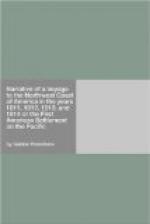I shall not undertake to describe New York; I will only say, that the elegance of the buildings, public and private, the cleanliness of the streets, the shade of the poplars which border them, the public walks, the markets always abundantly provided with all sorts of commodities, the activity of its commerce, then in a flourishing condition, the vast number of ships of all nations which crowded the quays; all, in a word, conspired to make me feel the difference between this great maritime city and my native town, of whose steeples I had never lost sight before, and which was by no means at that time what it is now.
New York was not then, and indeed is not at this time a fortified town; still there were several batteries and military works, the most considerable of which were seen on the Narrows, or channel which forms the principal mouth of the Hudson. The isles called Governor’s Island, and Bedloe or Gibbet Island, were also well fortified. On the first, situated to the west of the city and about a mile from it, there were barracks sufficiently capacious for several thousand soldiers, and a Moro, or castle, with three tiers of guns, all bomb-proof. These works have been strengthened during the last war.
The market-places are eight in number; the most considerable is called Fly-Market.
The Park, the Battery, and Vauxhall Garden, are the principal promenades. There were, in 1810, thirty-two churches, two of which were devoted to the catholic worship; and the population was estimated at ninety thousand souls, of whom ten thousand were French. It is thought that this population has since been augmented (1819) by some thirty thousand souls.
During my sojourn at New York, I lodged in Brooklyn, on Long Island. This island is separated from the city by a sound, or narrow arm of the sea. There is here a pretty village, not far from which is a basin, where some gun-boats were hauled up, and a few war vessels were on the stocks. Some barracks had been constructed here, and a guard was maintained.
Before leaving New York, it is well to observe that during our stay in that city, Mr. M’Kay thought it the part of prudence to have an interview with the minister plenipotentiary of his Britannic majesty, Mr. Jackson,[D] to inform him of the object of our voyage, and get his views in regard to the line of conduct we ought to follow in case of war breaking out between the two powers; intimating to him that we were all British subjects, and were about to trade under the American flag. After some moments of reflection Mr. Jackson told him, “that we were going on a very hazardous enterprise; that he saw our object was purely commercial, and that all he could promise us, was, that in case of a war we should be respected as British subjects and traders.”
[Footnote D: This gentleman was really charge d’affaires.]
This reply appeared satisfactory, and Mr. M’Kay thought we had nothing to apprehend on that side.




